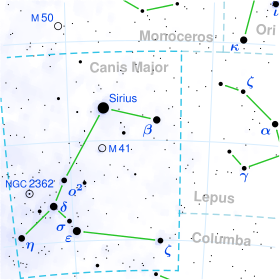| Observation data Epoch J2000 Equinox J2000 | |
|---|---|
| Constellation | Canis Major |
| Right ascension | 07h 18m 42.48642s[1] |
| Declination | −24° 57′ 15.7413″[1] |
| Apparent magnitude (V) | 4.40[2] (4.89 + 5.33 + 9.70[3]) |
| Characteristics | |
| Spectral type | O9II[4] (O9II + B0.5V + B0.5V[5]) |
| U−B color index | −0.99[2] |
| B−V color index | −0.15[2] |
| Variable type | β Lyr[6] |
| Astrometry | |
| Radial velocity (Rv) | +33.80[7] km/s |
| Proper motion (μ) | RA: −2.31[1] mas/yr Dec.: 5.02[1] mas/yr |
| Parallax (π) | 1.09 ± 0.59 mas[1] |
| Distance | 1,570[8] pc |
| Absolute magnitude (MV) | −5.9 + −3.6 + −3.6[5] |
| Details | |
| τ CMa Aa | |
| Mass | 50[9] M☉ |
| Radius | 19.8[10] R☉ |
| Luminosity | 280,000[11] L☉ |
| Surface gravity (log g) | 3.5[10] cgs |
| Temperature | 32,000[11] K |
| τ CMa Ab1 | |
| Mass | 17.8[9] M☉ |
| τ CMa Ab2 | |
| Mass | 17.8[9] M☉ |
| Other designations | |
| Database references | |
| SIMBAD | data |
Tau Canis Majoris (τ CMa, τ Canis Majoris, 30 CMa) is a multiple star system in the constellation Canis Major. It is approximately 5,000 light years distant from Earth and is the brightest member of the open cluster NGC 2362.
- ^ a b c d e Cite error: The named reference
hipparcoswas invoked but never defined (see the help page). - ^ a b c Cite error: The named reference
ducatiwas invoked but never defined (see the help page). - ^ Cite error: The named reference
wdswas invoked but never defined (see the help page). - ^ Cite error: The named reference
gossswas invoked but never defined (see the help page). - ^ a b Cite error: The named reference
sticklandwas invoked but never defined (see the help page). - ^ Cite error: The named reference
gcvswas invoked but never defined (see the help page). - ^ Cite error: The named reference
Pourbaixwas invoked but never defined (see the help page). - ^ a b c Cite error: The named reference
devrieswas invoked but never defined (see the help page). - ^ a b Cite error: The named reference
mnras189_601was invoked but never defined (see the help page). - ^ a b Cite error: The named reference
hohlewas invoked but never defined (see the help page).
